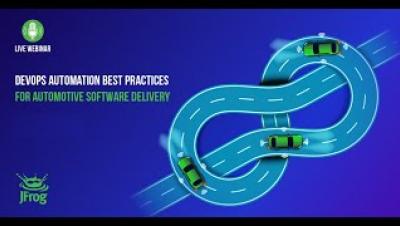Operations | Monitoring | ITSM | DevOps | Cloud
JFrog
JFrog CLI Completes You
JFrog CLI now supports autocomplete for both bash and zsh, allowing you to get your work done faster. With this functionality, you can now simply start typing your Bash and zsh commands and the CLI client will provide you with possible options to use. You can scroll through the options using tab. JFrog CLI helps simplify your automation work with the JFrog solutions. For example, using CLI with JFrog Distribution workflows to manage your software releases in a centralized platform.
Developers Driving DevOps at Scale: 5 Keys to Success - A Webinar Featuring Forrester Research
DevOps Automation Best Practices for Automotive Software Delivery
In this webinar you will learn:
- How DevOps helps solve the challenges around Automotive and Embedded software delivery
- What a modern CI/CD pipeline and toolset look like in the Automotive industry
- DevSecOps best practices: How to ensure security and compliance as an integral part of your pipeline
- Patterns for reducing the footprint/latency of last-mile deployments to speed-up releases and minimize service interruption
- Hard-won tips and tricks around increasing developer producti
Why GOPROXY Matters and Which to Pick
Starting with Go 1.13, Go modules are the standard package manager in Golang, automatically enabled on installation along with a default GOPROXY. But with other GOPROXY options like JFrog GoCenter, as well as your own Go module packages you need to keep secure from public view, what kind of configuration should you choose? How can you keep your public and private Golang resources from becoming a tangled knot?
DevOps Digital Transformation in 90 Days: Distribution
You’re digitally transforming yourself and your company in 90 days whether you like it or not. This is the new reality, as you find home office spaces (or lack of them), ways for kids to learn remotely, ways to conduct all of your family gatherings over a Zoom call, and more.
State of DevOps Cloud Solutions 2020
Every company claims to have a cloud/hybrid DevOps platform that enables and powers developers working remotely. Time to make order of the chaos.*
Hop Aboard Windows Containers on GKE
With Google’s new support for Windows containers on Google Kubernetes Engine, you might be eager to start bringing your .NET-compatible Docker workloads to Google Cloud Platform. JFrog is ready to help you hop aboard. In fact, Artifactory’s bags are already packed.
Free Go Module Vulnerability Scanning in Visual Studio Code
If you’re a Golang developer using Visual Studio Code, keeping at-risk Go Modules out of your apps just got easier, and for free. Today we’re announcing a new version of the JFrog extension for VS Code, available for free download. This integration brings live vulnerability information about every public Go Module you’re using directly into your source editor from the rich metadata of JFrog GoCenter.











